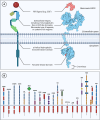Targeting Receptor Tyrosine Kinases as a Novel Strategy for the Treatment of Triple-Negative Breast Cancer
- PMID: 38389413
- PMCID: PMC10894558
- DOI: 10.1177/15330338241234780
Targeting Receptor Tyrosine Kinases as a Novel Strategy for the Treatment of Triple-Negative Breast Cancer
Abstract
Triple-negative breast cancer (TNBC) comprises a group of aggressive and heterogeneous breast carcinoma. Chemotherapy is the mainstay for the treatment of triple-negative tumors. Nevertheless, the success of chemotherapeutic treatments is limited by their toxicity and development of acquired resistance leading to therapeutic failure and tumor relapse. Hence, there is an urgent need to explore novel targeted therapies for TNBC. Receptor tyrosine kinases (RTKs) are a family of transmembrane receptors that are key regulators of intracellular signaling pathways controlling cell proliferation, differentiation, survival, and motility. Aberrant activity and/or expression of several types of RTKs have been strongly connected to tumorigenesis. RTKs are frequently overexpressed and/or deregulated in triple-negative breast tumors and are further associated with tumor progression and reduced survival in patients. Therefore, targeting RTKs could be an appealing therapeutic strategy for the treatment of TNBC. This review summarizes the current evidence regarding the antitumor activity of RTK inhibitors in preclinical models of TNBC. The review also provides insights into the clinical trials evaluating the use of RTK inhibitors for the treatment of patients with TNBC.
Keywords: AXL; EGFR; MET; receptor tyrosine kinases; small-molecule inhibitors; triple-negative breast cancer.
Conflict of interest statement
Declaration of Conflicting InterestsThe authors declared no potential conflicts of interest with respect to the research, authorship, and/or publication of this article.
Figures



Similar articles
-
Inhibition of Interleukin-8/C-X-C Chemokine Receptor 2 Signaling Axis Prevents Tumor Growth and Metastasis in Triple-Negative Breast Cancer Cells.Pharmacology. 2025;110(3):178-190. doi: 10.1159/000545659. Epub 2025 Apr 4. Pharmacology. 2025. PMID: 40188812 Free PMC article.
-
An update on cancer stem cell survival pathways involved in chemoresistance in triple-negative breast cancer.Future Oncol. 2025 Mar;21(6):715-735. doi: 10.1080/14796694.2025.2461443. Epub 2025 Feb 12. Future Oncol. 2025. PMID: 39936282 Review.
-
Pembrolizumab plus chemotherapy for first-line treatment of advanced triple-negative breast cancer.Future Oncol. 2024;20(22):1587-1600. doi: 10.2217/fon-2023-0301. Epub 2024 Apr 10. Future Oncol. 2024. PMID: 38597713 Free PMC article.
-
Challenges and resistance mechanisms to EGFR targeted therapies in head and neck cancers and breast cancer: Insights into RTK dependent and independent mechanisms.Oncotarget. 2025 Jun 25;16:508-530. doi: 10.18632/oncotarget.28747. Oncotarget. 2025. PMID: 40560045 Free PMC article. Review.
-
[Prognostic value of molecular markers IDO1, DCLK1 and FOXC1 in Triple-negative breast cancer: morphological and clinical correlations].Arkh Patol. 2025;87(3):88-96. doi: 10.17116/patol20258703188. Arkh Patol. 2025. PMID: 40531562 Review. Russian.
Cited by
-
Molecular characterization of colorectal cancer (CRC) using next generation sequencing (NGS) in bridging the gap between research and clinical practice: from biomarker discovery to clinical implementation.Discov Oncol. 2025 Mar 6;16(1):268. doi: 10.1007/s12672-025-01960-2. Discov Oncol. 2025. PMID: 40048017 Free PMC article.
-
Could Gas6/TAM Axis Provide Valuable Insights into the Pathogenesis of Systemic Sclerosis?Curr Issues Mol Biol. 2024 Jul 15;46(7):7486-7504. doi: 10.3390/cimb46070444. Curr Issues Mol Biol. 2024. PMID: 39057085 Free PMC article. Review.
-
Targeting c-Met in Cancer Therapy: Unravelling Structure-activity Relationships and Docking Insights for Enhanced Anticancer Drug Design.Curr Top Med Chem. 2025;25(4):409-433. doi: 10.2174/0115680266331025241015084546. Curr Top Med Chem. 2025. PMID: 39484763 Review.
-
Remodeling of tumour microenvironment: strategies to overcome therapeutic resistance and innovate immunoengineering in triple-negative breast cancer.Front Immunol. 2024 Dec 10;15:1455211. doi: 10.3389/fimmu.2024.1455211. eCollection 2024. Front Immunol. 2024. PMID: 39720730 Free PMC article. Review.
-
Inhibition of Interleukin-8/C-X-C Chemokine Receptor 2 Signaling Axis Prevents Tumor Growth and Metastasis in Triple-Negative Breast Cancer Cells.Pharmacology. 2025;110(3):178-190. doi: 10.1159/000545659. Epub 2025 Apr 4. Pharmacology. 2025. PMID: 40188812 Free PMC article.
References
-
- Sung H, Ferlay J, Siegel RL, et al. Global cancer statistics 2020: GLOBOCAN estimates of incidence and mortality worldwide for 36 cancers in 185 countries. CA Cancer J Clin. 2021;71(3):209-249. - PubMed
-
- The World Health Organization. Breast Cancer. Retrieved from: https://www.who.int/news-room/fact-sheets/detail/breast-cancer#, accessed on September 18th, 2023.
-
- Perou CM, Sorlie T, Eisen MB, et al. Molecular portraits of human breast tumours. Nature. 2000;406(6797):747-752. - PubMed
Publication types
MeSH terms
Substances
LinkOut - more resources
Full Text Sources
Research Materials
Miscellaneous

